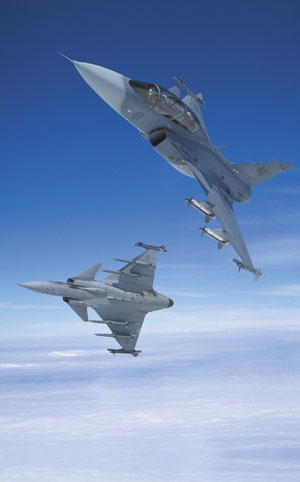Sweden Seeks Military Communications Flexibility
 |
| Initially focused on ground operations, Sweden’s network-based defense approach and software-defined radio (SDR) program will embrace and integrate land, sea and air, including the Gripen, within a joint network concept. Where available, space platforms also will support networking. |
The country’s aspirations for software-defined radios (SDRs) are not limited to hardware procurement, however. A series of planned projects will deepen waveform expertise on the terrestrial trunked radio (TETRA) waveform demonstrator project through a unique joint effort with the
Lt. Col. Sigvard Wiss, Swedish army, head of the Joint Telecom Branch, Swedish Armed Forces Headquarters, places
As an example, for the past 10 years,
To meet these new requirements,
The second thrust of the NBD transformation is the ongoing internationalization of the Swedish forces. Nonaligned during the Cold War, the country’s only international operations were peacekeeping missions under the United Nations flag. Consequently, coalition interoperability was not a priority. “Our defense force now has international missions as the main focus, and we will adopt international and NATO standards. The force must be able to conduct different operations under different flags. No matter how good, if the systems are not interoperable and cannot communicate with our coalition partners, then they are just not good enough,” Col. Wiss adds.
In outlining
Bilateral work also is important, and one of the countries
In addition,
The similarity between the terms GTRS and JTRS is not coincidental. “We were inspired by JTRS for our GTRS, which in many ways follows the JTRS program,” the major says. Indeed many of the same goals are shared: reducing soldiers’ burden by decreasing the number of radios and lessening logistics as a result of common modules and parts across the GTRS family. Adopting a single streamlined family of radios also would benefit procurement, he adds.
Ralph Persson, strategic specialist and chief engineer, Swedish Defense Materiel Administration (FMV), outlines the broad vision for SDRs in
One of the first examples of this approach has been the $16.7 million contract awarded to Rockwell Collins Incorporated,
In 2003, with support from the U.S. Army Communications–Electronics Research Development and Engineering Center, or CERDEC, Rockwell Collins was contracted to demonstrate ad hoc networking in Sweden using radios from its Multifunctional On-the-Move Secure Adaptive Integrated Communications (MOSAIC) program. Persson explains that the radios ordered are based on existing hardware platforms, but the modules for security will be developed specifically for
The GTRS demonstrator requirement, initially dubbed the Tactical Data Radio System, emerged from the need for a future battle management system for an armored battalion, namely the Stridsledningssystem Bataljon, or SLB. “Over the years, additional requirements emerged. It also became important for us to use this system to build knowledge, to improve our technical capabilities in terms of understanding how we handle waveforms, to develop our tactical abilities and to study how we can use this to specify requirements for ad hoc networking so that industry knows what we mean and we get what we ask for. So, besides the SLB, these radios will be used for trials with the aim of building knowledge,” Persson explains.
“We have urgent needs, but our strategy is that we are not going to be a large customer in the world market for SDRs; we are going to buy a couple of hundred at one time. This is not enough to encourage Swedish industry to begin development, so we are hoping to be able to buy from the international market. Frankly, we are counting on that,” he adds.
Persson refutes the view that this acquisition links future GTRS purchases to Rockwell Collins. “I want to say this very clearly: Our vision is to buy hardware and software independently.” He adds a proviso, however. “Today, if you have an aggressive time schedule and want to buy SDR software and hardware, it is probably quite difficult to compete with
Using this experience, the FMV is planning for further acquisitions. It is scheduled to begin the procurement process on handheld and manpack SDRs in early 2007 for delivery in 2009 followed by the purchase of a larger joint multichannel platform radio.
 |
| Rockwell Collins Incorporated will be delivering the first SDRs to the Swedish military next year. The radios will be used to conduct trials of the Stridsledningssystem Bataljon command and control system. |
Contracts awarded in 2005 to build the knowledge for developing waveform applications will help Swedish industry assess the road ahead. “We have an assessment now going on at Ericsson to try to evaluate the amount of work needed to develop the waveform for our national needs,” Persson explains. He anticipates that the current RA180 or combat net radio waveform will be one of the national waveforms. “It may be strange that we are beginning by developing an old waveform, but the GTRS demo system that we are buying from Rockwell Collins [already] has a waveform, and the radio will also support national waveforms. Even if [the GTRS demonstrator radio waveform] is based on a lot of U.S. Army MOSAIC-developed functionality, they have been certified as Swedish waveforms in that contract.” Other national Swedish waveforms exist, but
In terms of international cooperation and commitment,
“This is a project to develop a demonstrator waveform,” he explains. “I want to stress that it is a demonstrator waveform—it is not a production waveform—and consists of a subset of the TETRA mobile waveform. It is not going to be the full TETRA functionality,” he adds.
Persson states that the effort consists of three main activities. The first is to demonstrate SCA compliance with a mobile station waveform, implement a subset and port this to a radio then demonstrate interoperability with a real TETRA system. Second, it will be necessary to conduct a partial SCA certification. Finally, a cross-banding demonstration will be set up.
He cites two reasons that the TETRA waveform was selected as the basis for a joint U.S.-Swedish project. “One is that it should be readily available and used internationally, preferably by international civil organizations and by rescue organizations. The second issue, particularly for the
Al Emondi, chief scientist, communications department, U.S. Navy Space and
“We are developing the TETRA waveform between the
The joint effort between the two countries is structured so that the United States will be delivering layer one of the TETRA waveform, a representative SCA-compliant hardware platform—not a JTRS Cluster radio, and the software and support personnel to perform SCA compliance testing on the jointly developed waveform.
Work on TETRA has spawned a new term: initial SCA compliance. “We are developing a waveform that was not meant to be in the
The initial testing will look at the potentiality of porting but will not actually attempt it. “We wanted to make sure that we had good solid code in order to take the program onto subsequent phases. We are going to run the code on a
At this stage, information assurance is not being addressed other than to explore whether the addition of encryption is possible. However, he cautions, with many countries using TETRA, the challenge that multiple encryption algorithms would pose for interoperability would be considerable.
In cross-banding terms, both countries are still discussing final details. Emondi explains that use of a Project 25 public safety waveform was originally envisaged, but the failure to develop an SCA-compliant version meant this was impossible. A plain ‘‘vanilla’’ FM waveform operating in a
The
Interim SCA compliance testing is scheduled for completion by January 2007. To secure funding for the next phase, a series of demonstrations has been planned throughout this year to show the health of the project.
Progress in SDR development comes with an undoubted enthusiasm for the potential operational advantage it provides. However, this enthusiasm has been tempered with realism. “SDR is not a silver bullet that will solve all the problems, but it will solve many of them and the challenges that we are facing right now,” Col. Wiss says. “It is a big project. It is not something we can do ourselves. We are looking for international partners, and we believe that this will be done in close cooperation with many other nations.”
Adam Baddeley is a freelance technical writer based in the
Web Resources
Swedish Armed Forces Headquarters: www.hkv.mil.se/?lang=E
Swedish Defense Materiel Administration: www.fmv.se
Joint Tactical Radio System: http://jtrs.army.mil/index.html
European Defence Agency: www.eda.eu.int




Comments